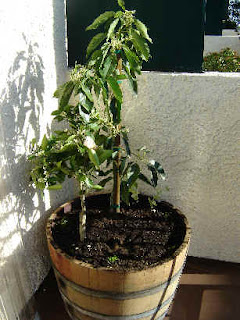Avocado trees come in a wide variety of cultivars that vary in the thickness of the skin and oil content of the fruit. Types also vary in their size, yield, salt tolerance, flesh quality and resistance to disease.
Sources of image
- Dwarf Avocado Varieties
Plant scientists developed a number of dwarf varieties of avocado suitable for growing in small spaces and containers. The "Little Cado" variety is the only true dwarf variety of avocado and will consistently product good fruit from May to September, according to the National Gardening Association.- Avocado Cultivation
Avocados need well-draining soil and do not thrive in clay soils that hold water at the root area. Plant avocados outdoors in raised beds at least 1 to 2 inches above the soil level. Do not plant the trees too deep. A 3- to 4-inch layer of mulch around the trees will help retain water and improve soil quality. Dwarf varieties in containers need frequent watering, according to FourWindsGrowers. Frequent pinching of young tree stems help to keep the tree in the desired shape. Plant windbreaks around avocado trees to protect them from strong winds. Fertilize with a well-balanced citrus food on a regular basis. Avocadoes will not ripen while still on the tree. Harvest when fruits are of mature size and still firm. They will ripen in one or two weeks at room temperature.- Avocado Problems
Though most avocado trees are self-fertile, some may suffer from pollination problems that prevent fruit growth. Planting with other avocado trees is recommended. Leafroller caterpillars can destroy branch tips. Six-spotted mites often cause large amounts of leaf shedding, while dothiorella canker can cause odorous, rotted areas in the trunk of trees. Root rot is often transferred from plant to plant on garden tools. A viral disease, sun bloth can cause yellowing of leaves and deformed fruit. To prevent the transfer of pathogens from plant to plant, clean garden tools with a 10 percent bleach solution between each use. Avocado plants, particularly young ones, can be damaged by sudden frosts and should be covered with blankets, sheets or landscape cloth for protection in cold weather.Sources of image

0 comments:
Post a Comment